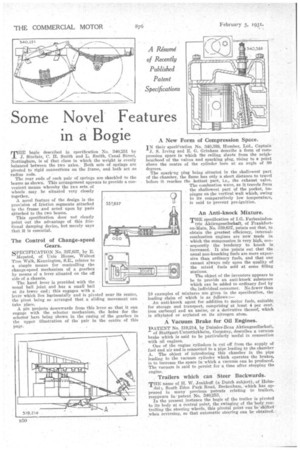Some Novel Features in a Bogie
Page 68

If you've noticed an error in this article please click here to report it so we can fix it.
TEE bogie described in specification No. 340,251 by J. Sinclair, C. H. Smith and L. Smith, Canal Street, Nottingham, is of that class in which the weight is evenly balanced between the two axles. Both sets of springs are pivoted to rigid connections on the frame, and. both act as radius rods.
The rear ends of each pair of springs are shackled to the beams as shown. This arrangement appears to provide a convenient means whereby the two sets of wheels . may be situated very closely together.
A novel feature of the design is the provision of friction segments .attached to the frame and acted Upon by pads attached to the two beams.
This specification does not clearly point out the advantage of this frictional damping device, but merely says that it is essential.
The Control of Change-speed Gears.
SPECIFICATION No. 337,637, by E. Mepsted, of Unic House, Walnut Tree Walk, Kennington, S.E., relates to a simple means for controlling the change-speed mechanism of a gearbox by means of a lever situated on the off side of a chassis.
The hand lever is provided with the usual ball joint and has a small ball at its lower end • this engages with a lever which lies horizontally and is pivoted near its centre, the pivot being so arranged that a sliding movement can take place.
A pin projects downwards from this lever so that it can engage . with the selector mechanism, the holes for the selector bars being shown in the easing of the gearbox in the upper illustration of the pair in the centre of this Page.
• A New Form of Compression Space.
IN their speeif cation No. 340,888, Humber, Ltd., Captain J. S. Irving and E. G. Grinham describe a form of compression space in which the ceiling slants from the neighbourhood of the valves and sparking plug, rising to a point above the centre of the cylinder bore at an angle of SO degrees.
The sparlong plug being situated in the shallowest part of the chamber, the flame has only a short distance to travel before it reaches the hottest part, i.e., the exhaust valve. The combustion wave, as it travels from the shallowest part of the pocket, impinges on the vertical wall which, owing to its comparatively low temperature, is said to prevent pre-ignition.
An Anti-knock Mixture.
THE specification of I.G. Farbenindus
trie Aktiengesellschaft, of Frankforton-Main, No. 339,637, points out that, to, obtain the greatest efficiency, internalcombustion engines are now made in which the compression is very high, consequently the tendency to knock is. increased. It also points out that the hsual non-knocking fuels are more expensive than ordinary fuels, and that one cannot always rely upon the quality of the mixed fuels sold at some filling stations.
The object of the inventors appears to be to provide an anti-knock substance which can be added to ordinary fuel by the individual consumer. No fewer than 10 examples of mixtures are given in the specification, the leading claim of which is as follows : An anti-knock agent for addition to motor fuels, suitable for storage and transport, comprising at least 4 per cent. iron carbonyl and an amine, or a derivative thereof, which is alkylated or arylated on its nitrogen atom.
A Vacuum Brake for Oil Engines.
pATENT No. 319,214, by Daimler-Benz Aktiengesellschaft, of Stuttgart-Untertiirkheim, Germany, describes a vacuum brake which is said to be particularly useful in connection
with ail engines. •
One of the engine cylinders is cut off from the supply of fuel and air and is connected to a pipe leading to the chamber A. The object of introducing this chamber in the pipe leading to the vacuum cylinder which operates the brakes, is to increase the space in which a vacuum can be produced. The vacuum is said to persist for a time after stopping, the engine.
Trailers which can Steer Backwards.
THE name of H. W. Jonkhoff (a Dutch subject), of Holm. .dali, South Edon Park Road, Beckenham, which has appeared in many previous patents relating to trailers, reappears in patent No. 340,253. • In the Present instance the bogie of the trailer is pivoted to its body at a central point, the swinging of the 'body controlling the steering wheels, this pivotal point can be shifted when reversing, so that automatic steering can be obtained.




































































































